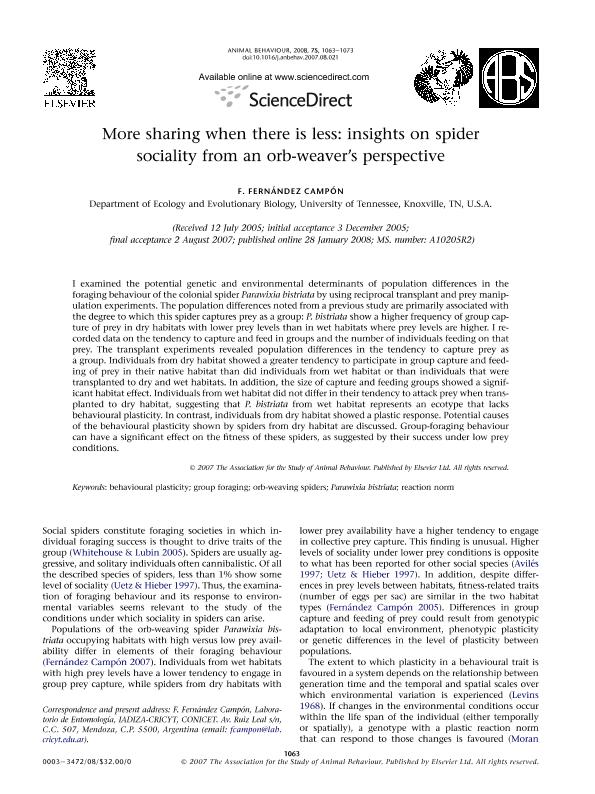Mostrar el registro sencillo del ítem
dc.contributor.author
Fernández Campón, María Florencia

dc.date.available
2019-12-26T14:18:18Z
dc.date.issued
2008-03
dc.identifier.citation
Fernández Campón, María Florencia; More sharing when there is less: insights on spider sociality from an orb-weaver's perspective; Academic Press Ltd - Elsevier Science Ltd; Animal Behaviour; 75; 3; 3-2008; 1063-1073
dc.identifier.issn
0003-3472
dc.identifier.uri
http://hdl.handle.net/11336/92895
dc.description.abstract
I examined the potential genetic and environmental determinants of population differences in the foraging behaviour of the colonial spider Parawixia bistriata by using reciprocal transplant and prey manipulation experiments. The population differences noted from a previous study are primarily associated with the degree to which this spider captures prey as a group: P. bistriata show a higher frequency of group capture of prey in dry habitats with lower prey levels than in wet habitats where prey levels are higher. I recorded data on the tendency to capture and feed in groups and the number of individuals feeding on that prey. The transplant experiments revealed population differences in the tendency to capture prey as a group. Individuals from dry habitat showed a greater tendency to participate in group capture and feeding of prey in their native habitat than did individuals from wet habitat or than individuals that were transplanted to dry and wet habitats. In addition, the size of capture and feeding groups showed a significant habitat effect. Individuals from wet habitat did not differ in their tendency to attack prey when transplanted to dry habitat, suggesting that P. bistriata from wet habitat represents an ecotype that lacks behavioural plasticity. In contrast, individuals from dry habitat showed a plastic response. Potential causes of the behavioural plasticity shown by spiders from dry habitat are discussed. Group-foraging behaviour can have a significant effect on the fitness of these spiders, as suggested by their success under low prey conditions.
dc.format
application/pdf
dc.language.iso
eng
dc.publisher
Academic Press Ltd - Elsevier Science Ltd

dc.rights
info:eu-repo/semantics/openAccess
dc.rights.uri
https://creativecommons.org/licenses/by-nc-sa/2.5/ar/
dc.subject
BEHAVIOURAL PLASTICITY
dc.subject
GROUP FORAGING
dc.subject
ORB-WEAVING SPIDERS
dc.subject
PARAWIXIA BISTRIATA
dc.subject
REACTION NORM
dc.subject.classification
Zoología, Ornitología, Entomología, Etología

dc.subject.classification
Ciencias Biológicas

dc.subject.classification
CIENCIAS NATURALES Y EXACTAS

dc.title
More sharing when there is less: insights on spider sociality from an orb-weaver's perspective
dc.type
info:eu-repo/semantics/article
dc.type
info:ar-repo/semantics/artículo
dc.type
info:eu-repo/semantics/publishedVersion
dc.date.updated
2019-10-10T19:34:57Z
dc.journal.volume
75
dc.journal.number
3
dc.journal.pagination
1063-1073
dc.journal.pais
Estados Unidos

dc.journal.ciudad
Amsterdam
dc.description.fil
Fil: Fernández Campón, María Florencia. University of Tennessee; Estados Unidos. Consejo Nacional de Investigaciones Científicas y Técnicas. Centro Científico Tecnológico Conicet - Mendoza. Instituto Argentino de Investigaciones de las Zonas Áridas. Provincia de Mendoza. Instituto Argentino de Investigaciones de las Zonas Áridas. Universidad Nacional de Cuyo. Instituto Argentino de Investigaciones de las Zonas Áridas; Argentina
dc.journal.title
Animal Behaviour

dc.relation.alternativeid
info:eu-repo/semantics/altIdentifier/doi/http://dx.doi.org/10.1016/j.anbehav.2007.08.021
dc.relation.alternativeid
info:eu-repo/semantics/altIdentifier/url/https://www.sciencedirect.com/science/article/pii/S0003347207005350
Archivos asociados
